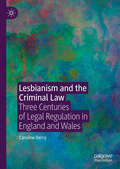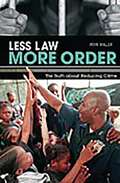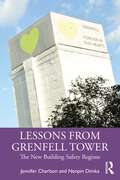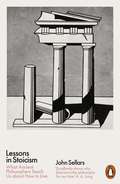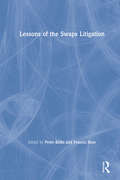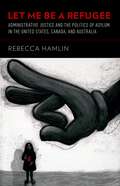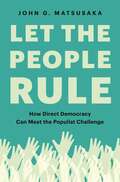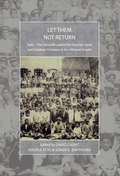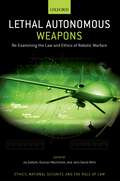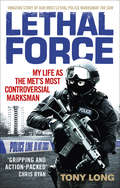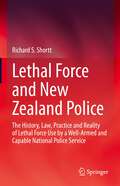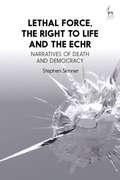- Table View
- List View
Lesbian, Gay, Bisexual and Trans People (LGBT) and the Criminal Justice System
by Charlotte Knight Kath WilsonThis book explores the experiences of lesbian, gay, bisexual and trans (LGBT) communities as victims, offenders and staff within the criminal justice system. It draws on both emerging and existing LGBT research and campaigns to identify and explore issues relevant to the criminal justice system, including: agencies of the criminal justice system, victimisation, domestic violence and abuse, transgender experiences, LGBT people as offenders, international perspectives and the personal experiences of LGBT people.Charlotte Knight and Kath Wilson trace the legislative journey toward equal treatment before and after the Wolfenden Report. They consider why, for example, lesbians are over represented on death row in the US, how the prosecution characterises them and what part homophobia might play in offending and in sentencing. They raise important questions about the causes of, and responses to, same-sex domestic violence and abuse and how the system delivers justice to trans people. Sodomy laws and the treatment of LGBT people worldwide are also considered and models of good practice are offered. Their insights will be of interest to practitioners, policy makers and scholars of the criminal justice system, particularly those concerned with the rights of LGBT communities.
Lesbianism and the Criminal Law: Three Centuries of Legal Regulation in England and Wales
by Caroline DerryThis book offers a comprehensive examination of the ways in which the criminal justice system of England and Wales has regulated, and failed or refused to regulate, lesbianism. It identifies the overarching approach as one of silencing: lesbianism has not only been ignored or regarded as unimaginable, but was deliberately excluded from legal discourses. A series of case studies ranging from 1746 to 2013 from parliamentary debates to individual prosecutions shed light on the complex process of regulation through silencing. They illuminate its evolution over three centuries and explore when and why it has been breached. The answers Derry uncovers can be fully understood only in the context of surrounding social and legal developments which are also considered. Lesbianism and the Criminal Law makes an important contribution to the growing bodies of literature on feminism, sexuality and the law and the legal history of sexual offences.
Less Law, More Order: The Truth about Reducing Crime
by Irvin WallerEach year 24 million Americans are victims of crime. U.S. taxpayers spend more and more each year on police, prisons and judges—a record $200 billion at last count. They incarcerate more and more persons each year—two million plus. Yet prestigious commissions show not only that this standard way of responding to crime is ineffective but that there is scientific proof that many projects that tackle risk factors that cause crime are effective. Rather than sending more people to jail or hiring more and more police, the author, and the research, shows that addressing problems in the community does more to prevent crime. This timely book illustrates in convincing detail what needs to be done to prevent crime and keep people out of prison.Here, Waller shows that hiring public health nurses and investing in helping youth at risk to complete school and get job training is better than hiring more police; preventing family violence, banning hand guns and dealing with drugs through public health saves more lives than incarceration; getting close neighbors to watch out for us and better industrial design are more effective than criminal courts; smarter policing is better than more police; paying for services to support victims and guaranteeing them rights is better than more rhetoric. Addressing the social issues that lead to crime, rather than addressing crime after it happens, or putting stiffer penalties in place, will contribute to creating a safer society and to keeping kids and adults from taking the wrong path toward a life of crime.
Lesser Harms: The Morality of Risk in Medical Research (Morality and Society Series)
by Sydney A. HalpernResearch physicians face intractable dilemmas when they consider introducing new medical procedures. Innovations carry the promise of preventing or curing life-threatening diseases, but they can also lead to injury or even death. How have clinical scientists made high-stakes decisions about undertaking human tests of new medical treatments? In Lesser Harms, Sydney Halpern explores this issue as she examines vaccine trials in America during the early and mid-twentieth century. Today's scientists follow federal guidelines for research on human subjects developed during the 1960s and 1970s. But long before these government regulations, medical investigators observed informal rules when conducting human research. They insisted that the dangers of natural disease should outweigh the risks of a medical intervention, and they struggled to accurately assess the relative hazards. Halpern explores this logic of risk in immunization controversies extending as far back as the eighteenth century. Then, focusing on the period between 1930 and 1960, she shows how research physicians and their sponsors debated the moral quandaries involved in moving vaccine use from the laboratory to the clinic. This probing work vividly describes the efforts of clinical investigators to balance the benefits and dangers of untested vaccines, to respond to popular sentiment about medical hazards, and to strategically present risk laden research to sponsors and the public. “Concise and extremely well-written. . . . A fascinating synthesis of sociology, history, and institutional theory.”—Samuel C. Blackman, Journal of the American Medical Association
Lesser Harms: The Morality of Risk in Medical Research (Morality and Society Series)
by Sydney A. HalpernResearch physicians face intractable dilemmas when they consider introducing new medical procedures. Innovations carry the promise of preventing or curing life-threatening diseases, but they can also lead to injury or even death. How have clinical scientists made high-stakes decisions about undertaking human tests of new medical treatments? In Lesser Harms, Sydney Halpern explores this issue as she examines vaccine trials in America during the early and mid-twentieth century. Today's scientists follow federal guidelines for research on human subjects developed during the 1960s and 1970s. But long before these government regulations, medical investigators observed informal rules when conducting human research. They insisted that the dangers of natural disease should outweigh the risks of a medical intervention, and they struggled to accurately assess the relative hazards. Halpern explores this logic of risk in immunization controversies extending as far back as the eighteenth century. Then, focusing on the period between 1930 and 1960, she shows how research physicians and their sponsors debated the moral quandaries involved in moving vaccine use from the laboratory to the clinic. This probing work vividly describes the efforts of clinical investigators to balance the benefits and dangers of untested vaccines, to respond to popular sentiment about medical hazards, and to strategically present risk laden research to sponsors and the public. “Concise and extremely well-written. . . . A fascinating synthesis of sociology, history, and institutional theory.”—Samuel C. Blackman, Journal of the American Medical Association
Lesser Harms: The Morality of Risk in Medical Research (Morality and Society Series)
by Sydney A. HalpernResearch physicians face intractable dilemmas when they consider introducing new medical procedures. Innovations carry the promise of preventing or curing life-threatening diseases, but they can also lead to injury or even death. How have clinical scientists made high-stakes decisions about undertaking human tests of new medical treatments? In Lesser Harms, Sydney Halpern explores this issue as she examines vaccine trials in America during the early and mid-twentieth century. Today's scientists follow federal guidelines for research on human subjects developed during the 1960s and 1970s. But long before these government regulations, medical investigators observed informal rules when conducting human research. They insisted that the dangers of natural disease should outweigh the risks of a medical intervention, and they struggled to accurately assess the relative hazards. Halpern explores this logic of risk in immunization controversies extending as far back as the eighteenth century. Then, focusing on the period between 1930 and 1960, she shows how research physicians and their sponsors debated the moral quandaries involved in moving vaccine use from the laboratory to the clinic. This probing work vividly describes the efforts of clinical investigators to balance the benefits and dangers of untested vaccines, to respond to popular sentiment about medical hazards, and to strategically present risk laden research to sponsors and the public. “Concise and extremely well-written. . . . A fascinating synthesis of sociology, history, and institutional theory.”—Samuel C. Blackman, Journal of the American Medical Association
Lessons for Climate Change Adaptation from Better Management of Rivers (Climate and Development Series)
by Jamie PittockClimate change is dramatically affecting freshwater supplies, particularly in the developing world. The papers in this volume present a powerful case for and exploration of different freshwater adaptation strategies in the face of global climatic change. The volume centres on six detailed case studies, from India, China, Mexico, Brazil, the lower Danube basin and Tanzania, written by experienced local academics and practitioners. They assess autonomous adaptation in the freshwater sector, drawing out key lessons about what motivated these societies to change, which factors led to more successful adaptation, and how interventions may best be sustained. The volume also contains a global overview of the lessons derived from these experiences. It sheds light on two key theories: that vulnerability to climate change is best reduced by reducing poverty and promoting sustainable development first, or by reducing bio-physical risks from climate change. The publication also highlights the need to ensure that access to more precise climate change impact data is not used as an excuse to delay implementation of no regrets adaptation measures.
Lessons for Climate Change Adaptation from Better Management of Rivers (Climate and Development Series)
by Jamie PittockClimate change is dramatically affecting freshwater supplies, particularly in the developing world. The papers in this volume present a powerful case for and exploration of different freshwater adaptation strategies in the face of global climatic change. The volume centres on six detailed case studies, from India, China, Mexico, Brazil, the lower Danube basin and Tanzania, written by experienced local academics and practitioners. They assess autonomous adaptation in the freshwater sector, drawing out key lessons about what motivated these societies to change, which factors led to more successful adaptation, and how interventions may best be sustained. The volume also contains a global overview of the lessons derived from these experiences. It sheds light on two key theories: that vulnerability to climate change is best reduced by reducing poverty and promoting sustainable development first, or by reducing bio-physical risks from climate change. The publication also highlights the need to ensure that access to more precise climate change impact data is not used as an excuse to delay implementation of no regrets adaptation measures.
Lessons from Grenfell Tower: The New Building Safety Regime
by Jennifer Charlson Nenpin DimkaAs a consequence of the Grenfell Tower fire, a building safety revolution is underway for construction and property professionals. This book analyses prior significant building fires and explains the new building safety regime including the Building Safety Act 2022 and the Building Safety Regulator. The aim is to provide an explanation of the Building Safety Regime. To that end, coverage includes: The Grenfell Tower fire: the Hackitt Review and Public Inquiry Remediation of existing buildings Legal Framework: the Fire Safety Act 2021 and Building Safety Act 2022 Building Regulations: Part B Revisions and the Combustible Material Ban The Building Safety Regulator Guidance and Consultations Change has arrived for construction and property professionals in the wake of the Grenfell Tower fire. This book is for readers who have responsibilities in the Built Environment or Real Estate to take the first steps towards implementation and compliance with the new regime.
Lessons from Grenfell Tower: The New Building Safety Regime
by Jennifer Charlson Nenpin DimkaAs a consequence of the Grenfell Tower fire, a building safety revolution is underway for construction and property professionals. This book analyses prior significant building fires and explains the new building safety regime including the Building Safety Act 2022 and the Building Safety Regulator. The aim is to provide an explanation of the Building Safety Regime. To that end, coverage includes: The Grenfell Tower fire: the Hackitt Review and Public Inquiry Remediation of existing buildings Legal Framework: the Fire Safety Act 2021 and Building Safety Act 2022 Building Regulations: Part B Revisions and the Combustible Material Ban The Building Safety Regulator Guidance and Consultations Change has arrived for construction and property professionals in the wake of the Grenfell Tower fire. This book is for readers who have responsibilities in the Built Environment or Real Estate to take the first steps towards implementation and compliance with the new regime.
Lessons From the Bench: Reflections on a Career Spent in Ireland's Criminal Courts
by Judge Gillian HusseyWhen Gillian Hussey started out in Bridewell District Court in 1984, little did she realise that she would deal with some of the most notorious criminals in Ireland, including the Kinahans, the Cahills, ‘The Monk’ and John Gilligan.As one of Ireland’s first female judges, Gillian was very much a woman in a man’s world. Unafraid to look beyond the courtroom, she always sought to better understand the human – not just the criminal – who stood before her in the dock. Through her work, Gillian spent a lifetime learning about people, society and herself.This fascinating insight into the career of a trailblazing woman reveals the inner workings of Ireland’s criminal courts, explores the changes in Irish society and shares some timeless truths learned from almost twenty years on the bench.
Lessons from the Identity Trail: Anonymity, Privacy and Identity in a Networked Society
by Ian Kerr Carole Lucock Valerie SteevesDuring the past decade, rapid developments in information and communications technology have transformed key social, commercial and political realities. Within that same time period, working at something less than internet speed, much of the academic and policy debates arising from these new and emerging technologies have been fragmented. There have been few examples of interdisciplinary dialogue about the potential for anonymity and privacy in a networked society. Lessons from the Identity Trail fills that gap, and examines key questions about anonymity, privacy and identity in an environment that increasingly automates the collection of personal information and uses surveillance to reduce corporate and security risks. This project has been informed by the results of a multi-million dollar research project that has brought together a distinguished array of philosophers, ethicists, feminists, cognitive scientists, lawyers, cryptographers, engineers, policy analysts, government policy makers and privacy experts. Working collaboratively over a four-year period and participating in an iterative process designed to maximize the potential for interdisciplinary discussion and feedback through a series of workshops and peer review, the authors have integrated crucial public policy themes with the most recent research outcomes.
Lessons in Censorship: How Schools And Courts Subvert Students' First Amendment Rights
by Catherine J. RossAmerican public schools censor controversial student speech that the Constitution protects. Catherine Ross brings clarity to court rulings that define speech rights of young citizens and proposes ways to protect free expression, arguing that the failure of schools to respect civil liberties betrays their educational mission and threatens democracy.
Lessons in Stoicism: What Ancient Philosophers Teach Us about How to Live
by John SellarsA deeply comforting and enlightening book on how Stoicism can inspire us to lead more enjoyable livesWhat aspects of your life do you really control? What do you do when you cannot guarantee that things will turn out in your favour? And what can Stoicism teach us about how to live together?In the past few years, Stoicism has been making a comeback. But what exactly did the Stoics believe? In Lessons in Stoicism, philosopher John Sellars weaves together the key ideas of the three great Roman Stoics -- Seneca, Epictetus and Marcus Aurelius -- with snapshots of their fascinating lives, to show us how their ideas can help us today. In vivid prose, Sellars shows how the works of these three Stoics have inspired readers ever since, speaking as they do to some of the perennial issues that face anyone trying to navigate their way through life. Their works, fundamentally, are about how to live -- how to understand one's place in the world, how to cope when things don't go well, how to manage one's emotions and how to behave towards others. Consoling and inspiring, Lessons in Stoicism is a deeply thoughtful guide to the philosophy of a good life.
Lessons Learned from the 2020 U.S. Presidential Election: Hindsight is 2020 (Elections, Voting, Technology)
by Joseph A. Coll Joseph AnthonyIn this book, leading and emerging election scholars document the steps that state and local election officials took to augment their elections during the COVID-19 pandemic and the effects of these changes. Written for academics, practitioners, and election laypeople, this book details what went right, what went wrong, and what we can learn from the 2020 US presidential election. The 2020 election cycle was unique in American history. Held during the COVID-19 pandemic, efforts were made at the federal, state, and local levels to ensure voters could safely access elections. These changes included providing greater access to mail/absentee voting, installing ballot drop boxes, outfitting polling places with protective equipment, and much more. Many of these changes were politicized, with Republicans and Democrats viewing these changes differently. Contributing authors address how states and localities altered their elections in light of the pandemic; poll worker motivation for working during a health crisis, and how the changes to elections were viewed by election officials; the effects of these changes on whether a citizen decided to cast a ballot, how they voted, and who they voted for; how these changes influenced evaluations of elections, how long voters waited to cast a ballot, and their confidence in the outcome of the election; and, finally, what we can learn about election administration, access, and evaluations from this historic election.
Lessons of the Swaps Litigation
by Peter Birks Francis RoseThis is the first comprehensive review of the extent of remedies and impact of contractual agreements on restitution claims for void, unenforceable, and discharged contracts.
Lessons of the Swaps Litigation
by Peter Birks and Francis RoseThis is the first comprehensive review of the extent of remedies and impact of contractual agreements on restitution claims for void, unenforceable, and discharged contracts.
Let Me Be a Refugee: Administrative Justice and the Politics of Asylum in the United States, Canada, and Australia
by Rebecca HamlinInternational law provides states with a common definition of a "refugee" as well as guidelines outlining how asylum claims should be decided. Yet even across nations with many commonalities, the processes of determining refugee status look strikingly different. This book compares the refugee status determination (RSD) regimes of three popular asylum seeker destinations: the United States, Canada, and Australia. Though they exhibit similarly high levels of political resistance to accepting asylum seekers, refugees access three very different systems-none of which are totally restrictive or expansive-once across their borders. These differences are significant both in terms of asylum seekers' experience of the process and in terms of their likelihood of being designated as refugees. Based on a multi-method analysis of all three countries, including a year of fieldwork with in-depth interviews of policy-makers and asylum-seeker advocates, observations of refugee status determination hearings, and a large-scale case analysis, Rebecca Hamlin finds that cross-national differences have less to do with political debates over admission and border control policy than with how insulated administrative decision-making is from either political interference or judicial review. Administrative justice is conceptualized and organized differently in every state, and so states vary in how they draw the line between refugee and non-refugee.
Let the People Rule: How Direct Democracy Can Meet the Populist Challenge
by John G. MatsusakaHow referendums can diffuse populist tensions by putting power back into the hands of the peoplePropelled by the belief that government has slipped out of the hands of ordinary citizens, a surging wave of populism is destabilizing democracies around the world. As John Matsusaka reveals in Let the People Rule, this belief is based in fact. Over the past century, while democratic governments have become more efficient, they have also become more disconnected from the people they purport to represent. The solution Matsusaka advances is familiar but surprisingly underused: direct democracy, in the form of referendums. While this might seem like a dangerous idea post-Brexit, there is a great deal of evidence that, with careful design and thoughtful implementation, referendums can help bridge the growing gulf between the government and the people.Drawing on examples from around the world, Matsusaka shows how direct democracy can bring policies back in line with the will of the people (and provide other benefits, like curbing corruption). Taking lessons from failed processes like Brexit, he also describes what issues are best suited to referendums and how they should be designed, and he tackles questions that have long vexed direct democracy: can voters be trusted to choose reasonable policies, and can minority rights survive majority decisions? The result is one of the most comprehensive examinations of direct democracy to date—coupled with concrete, nonpartisan proposals for how countries can make the most of the powerful tools that referendums offer.With a crisis of representation hobbling democracies across the globe, Let the People Rule offers important new ideas about the crucial role the referendum can play in the future of government.
Let Them Not Return: Sayfo – The Genocide Against the Assyrian, Syriac, and Chaldean Christians in the Ottoman Empire (War and Genocide #26)
by David GauntThe mass killing of Ottoman Armenians is today widely recognized, both within and outside scholarly circles, as an act of genocide. What is less well known, however, is that it took place within a broader context of Ottoman violence against minority groups during and after the First World War. Among those populations decimated were the indigenous Christian Assyrians (also known as Syriacs or Chaldeans) who lived in the borderlands of present-day Turkey, Iran, and Iraq. This volume is the first scholarly edited collection focused on the Assyrian genocide, or “Sayfo” (literally, “sword” in Aramaic), presenting historical, psychological, anthropological, and political perspectives that shed much-needed light on a neglected historical atrocity.
Lethal Autonomous Weapons: Re-Examining the Law and Ethics of Robotic Warfare (Ethics, National Security, and the Rule of Law)
by Jai Galliott, Duncan MacIntosh, Jens David OhlinThe question of whether new rules or regulations are required to govern, restrict, or even prohibit the use of autonomous weapon systems has been the subject of debate for the better part of a decade. Despite the claims of advocacy groups, the way ahead remains unclear since the international community has yet to agree on a specific definition of Lethal Autonomous Weapon Systems and the great powers have largely refused to support an effective ban. In this vacuum, the public has been presented with a heavily one-sided view of Killer Robots. This volume presents a more nuanced approach to autonomous weapon systems that recognizes the need to progress beyond a discourse framed by the Terminator and HAL 9000. Re-shaping the discussion around this emerging military innovation requires a new line of thought and a willingness to challenge the orthodoxy. Lethal Autonomous Weapons focuses on exploring the moral and legal issues associated with the design, development and deployment of lethal autonomous weapons. In this volume, we bring together some of the most prominent academics and academic-practitioners in the lethal autonomous weapons space and seek to return some balance to the debate. As part of this effort, we recognize that society needs to invest in hard conversations that tackle the ethics, morality, and law of these new digital technologies and understand the human role in their creation and operation.
Lethal Autonomous Weapons: Re-Examining the Law and Ethics of Robotic Warfare (Ethics, National Security, and the Rule of Law)
The question of whether new rules or regulations are required to govern, restrict, or even prohibit the use of autonomous weapon systems has been the subject of debate for the better part of a decade. Despite the claims of advocacy groups, the way ahead remains unclear since the international community has yet to agree on a specific definition of Lethal Autonomous Weapon Systems and the great powers have largely refused to support an effective ban. In this vacuum, the public has been presented with a heavily one-sided view of Killer Robots. This volume presents a more nuanced approach to autonomous weapon systems that recognizes the need to progress beyond a discourse framed by the Terminator and HAL 9000. Re-shaping the discussion around this emerging military innovation requires a new line of thought and a willingness to challenge the orthodoxy. Lethal Autonomous Weapons focuses on exploring the moral and legal issues associated with the design, development and deployment of lethal autonomous weapons. In this volume, we bring together some of the most prominent academics and academic-practitioners in the lethal autonomous weapons space and seek to return some balance to the debate. As part of this effort, we recognize that society needs to invest in hard conversations that tackle the ethics, morality, and law of these new digital technologies and understand the human role in their creation and operation.
Lethal Force: My Life As the Met’s Most Controversial Marksman
by Tony LongTony Long was the best ‘shot’ the Met ever had. Under the codename ‘Echo 7’, he was ‘licenced to kill’ bringing down scores of targets, sometimes with deadly force. In 1985 he opened fire on a suspect to save a four-year-old girl whose mother had been stabbed to death by her assailant. Two years later he was involved in another high profile shooting while confronting three armed criminals. On both occasions Tony was commended by the Metropolitan Police Commissioner. But in the spring of 2005, coming face to face with suspected drug dealer and armed robber Azelle Rodney, a volley of point blank shots would bring his career crashing to an end, tarnish his reputation and leave him fighting a murder charge and possible life sentence. From life or death cases and botched operations to political fallouts, this book charts the controversial career from rookie seventies beat cop to Long's command of SO19 – the Met’s most elite specialist firearms unit. Long’s personal testimony and professional insight raises serious issues about the duties, pressures and responsibilities that fall on the shoulders of those we task to risk their lives, and take the lives of others, in our name.
Lethal Force and New Zealand Police: The History, Law, Practice and Reality of Lethal Force Use by a Well-Armed and Capable National Police Service
by Richard S. ShorttThis book challenges the notion that the New Zealand Police are one of only four global police services that does not have routinely armed officers, using arguments and facts drawn from 2000 to 2019, a period of important change for the organisation and its relationship with firearms, particularly following the outrages of the Christchurch mosques terrorist massacres in 2019, and the 2020 shooting death of a young police constable in Aotearoa New Zealand. This book provides a brief history of the Police from its beginnings to the present day with a specific focus on its relationship with firearms, which contextualize the law that justifies use of lethal force in a country that has abolished the death penalty. It examines police policies, procedures, training and structures governing deployment and use of firearms in Aotearoa New Zealand, and the independent oversight that now applies to fatal and non-fatal shootings by Police. Using 43 publicly released oversight agency reports and data directly related to police shootings, such as who is being shot, this book investigates how the police are using lethal force, who is being affected, and what this might mean for the service with regards to the operational deployment of firearms and the potential for use of lethal force within the community into the future.
Lethal Force, the Right to Life and the ECHR: Narratives of Death and Democracy
by Stephen SkinnerIn its case law on the use of lethal and potentially lethal force, the European Court of Human Rights declares a fundamental connection between the right to life in Article 2 of the European Convention on Human Rights and democratic society. This book discusses how that connection can be understood by using narrative theory to explore Article 2 law's specificities and its deeper historical, social and political significance. Focusing on the domestic policing and law enforcement context, the book draws on an extensive analysis of case law from 1995 to 2017. It shows how the connection with democratic society in Article 2's substantive and procedural dimensions underlines the right to life's problematic duality, as an expression of a basic value demanding a high level of protection and a contextually limited provision allowing states leeway in the use of force. Emphasising the need to identify clear standards in the interpretation and application of the right to life, the book argues that Article 2 law's narrative dimensions bring to light its core purposes and values. These are to extract meaning from pain and death, ground democratic society's foundational distinction between acceptable force and unacceptable violence, and indicate democratic society's essential attributes as a restrained, responsible and reflective system.

